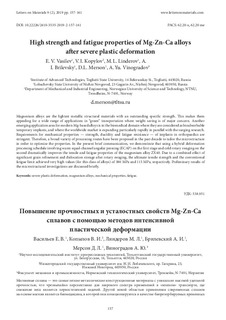| dc.contributor.author | Vasilev, Evgeni | |
| dc.contributor.author | Kopylov, Vladimir I | |
| dc.contributor.author | Linderov, Mikhail L. | |
| dc.contributor.author | Brilevsky, AI | |
| dc.contributor.author | Merson, Dmitri | |
| dc.contributor.author | Vinogradov, Alexey | |
| dc.date.accessioned | 2020-01-31T07:59:08Z | |
| dc.date.available | 2020-01-31T07:59:08Z | |
| dc.date.created | 2019-08-13T11:40:40Z | |
| dc.date.issued | 2019 | |
| dc.identifier.citation | Letters on Materials. 2019, 9 (2), 157-161. | nb_NO |
| dc.identifier.issn | 2218-5046 | |
| dc.identifier.uri | http://hdl.handle.net/11250/2638961 | |
| dc.description.abstract | Magnesium alloys are the lightest metallic structural materials with an outstanding specific strength. This makes them appealing for a wide range of applications in “green” transportation where weight saving is of major concern. Another emerging application area for modern Mg-based alloys is in the biomedical domain where they are considered as bioabsorbable temporary implants, and where the worldwide market is expanding particularly rapidly in parallel with the surging research. Requirements for mechanical properties - strength, ductility and fatigue resistance - of implants in orthopaedics are stringent. Therefore, a broad variety of processing routes have been proposed in the past decade to tailor the microstructure in order to optimize the properties. In the present brief communication, we demonstrate that using a hybrid deformation processing schedule involving warm equal-channel angular pressing (ECAP) on the first stage and cold rotary swaging on the second dramatically improves the tensile and fatigue properties of the magnesium alloy ZX40. Due to a combined effect of significant grain refinement and dislocation storage after rotary swaging, the ultimate tensile strength and the conventional fatigue limit achieved very high values (for this class of alloys) of 380 MPa and 115 MPa, respectively. Preliminary results of the microstructural investigations are discussed briefly. | nb_NO |
| dc.language.iso | eng | nb_NO |
| dc.publisher | Institute for Metals Superplasticity Problems of Russian Academy of Sciences | nb_NO |
| dc.rights | Navngivelse 4.0 Internasjonal | * |
| dc.rights.uri | http://creativecommons.org/licenses/by/4.0/deed.no | * |
| dc.title | High strength and fatigue properties of Mg-Zn-Ca alloys after severe plastic deformation | nb_NO |
| dc.type | Journal article | nb_NO |
| dc.type | Peer reviewed | nb_NO |
| dc.description.version | publishedVersion | nb_NO |
| dc.source.pagenumber | 157-161 | nb_NO |
| dc.source.volume | 9 | nb_NO |
| dc.source.journal | Letters on Materials | nb_NO |
| dc.source.issue | 2 | nb_NO |
| dc.identifier.doi | 10.22226/2410-3535-2019-2-157-161 | |
| dc.identifier.cristin | 1715541 | |
| dc.description.localcode | Licensed under a Creative Commons Attribution Licence (CC BY) | nb_NO |
| cristin.unitcode | 194,64,92,0 | |
| cristin.unitname | Institutt for maskinteknikk og produksjon | |
| cristin.ispublished | true | |
| cristin.fulltext | original | |
| cristin.qualitycode | 1 | |

